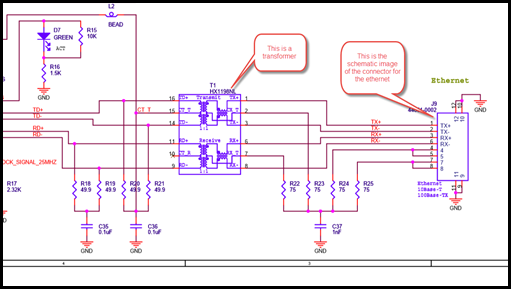Arduino/Netduino: Transformers and connecting to the internet using Ethernet
So what do you use the Ethernet for? To catch an Ether Bunny… Get it, huh? Get it? Seriously that is my best joke ever! Good thing I am not a stand-up comedian right?
Anyway, in my wandering around the forest of technology, I am on a path to connect my Netduino to the internet. Why not the Arduino? Because outside of the Spark, the Arduino really requires another “shield” which I will get later today, for a cost of course, and hopefully the local Radio Shack has it because I forgot to order the part from Amazon. In this blog we will take a look at the electronic schematic of the Netduino board and look at the very essence of the Ethernet to CPU connection.
Some Physics: Transformers
So the Netduino Plus 2 has a network connection and the little transformer that is required to keep the CPU circuit safe from transient voltages, etc. On a schematic it looks like the following, this is how the circuit is put together when an engineer is designing prior to building the PC board.
A transformer is used for a number of electrical jobs. For instance power is delivered from the generation stations at a very high voltage, sometimes as high as 120,000 Volts AC. Usually at your street you will see big cans on the poles, these are transformers. So called because they transform a higher voltage to a lower voltage in this example. Transformers can go the other way as well, from lower to higher. Working with wall power can be very dangerous, so even if you are an adult, if you are working with transformers do it with other people around, because you could die. Seriously.
But in this case we use the transformer to condition the Ethernet incoming waveform, which looks like this.
Now that is a fancy oscilloscope image, usually when dealing with digital stuff you can live without an Oscope most of the time. But when you need one, you will definitely wish you had something laying about that would do the job. I just ordered a super cheap oscilloscope from Amazon, won’t tell you which one till I get it and see if it actually does anything. Reviews are not all that good, but…for the price it is worth it to see if can be improved. If not I will ship it back to Amazon.
More Physics about Transformers
Ok, let me be very clear, you can hurt yourself with transformers, they can create a serious electrical situation. I won’t embed the video, but Edison made a movie using film of course of the electrocution of an elephant (an elephant that was going to be hanged if this experiment wasn’t done because it killed a person). Keep in mind, our view of this ghastly event is not the same way people viewed the event during that timeframe, electricity was new and frankly people didn’t know it was dangerous.
If you are using small transformers like the conditioning one on our Netduino Plus 2 board, you can see that the little transformer box will burn up before you can be hurt. However, if you use the larger transformers you might find around the house, this is not the case if you reverse the transformer and create a step-down circuit. For a simple explanation see: https://www.energyquest.ca.gov/how_it_works/transformer.html (real simple, the science and engineering is much more complex).
Conclusion:
Things are changing in software, where you used to be able to avoid the physics stuff, you can’t anymore, with the Internet of Things, you will need to understand the physics of electricity a lot better. So don’t ignore or dry lab your DC and AC circuits in physics, those are very important.
